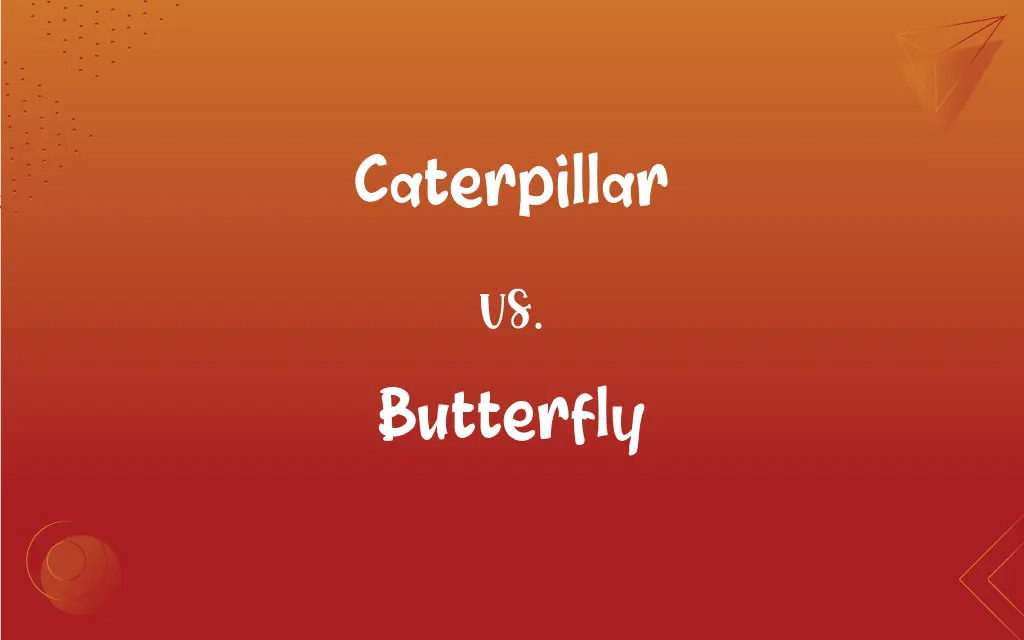Caterpillar vs. Butterfly: What's the Difference?
Edited by Janet White || By Harlon Moss || Updated on October 8, 2023
Caterpillars are the larval stage of butterflies, exhibiting a worm-like body and primarily eating leaves. Butterflies are the adult stage, featuring wings and primarily drinking nectar.

Key Differences
Caterpillars represent a crucial, transformative stage in the life cycle of a butterfly. This phase is predominantly about feeding and growth, wherein caterpillars gorge on leaves to amass energy and mass for the impending metamorphosis. Meanwhile, butterflies represent the culmination of this transformation, exhibiting vibrant wings and embodying symbols of beauty and transformation in various cultures.
The physical appearances of caterpillars and butterflies are vastly different, reflecting their divergent life stages and purposes. Caterpillars are typically elongated and segmented, moving with a distinctive ripple through numerous tiny, gripping feet. Butterflies, on the other hand, possess expansive, often-colorful wings, enabling them to fly, access food sources like nectar from flowers, and migrate over remarkable distances in some species.
In the context of feeding habits, caterpillars and butterflies also present clear distinctions. Caterpillars are voracious eaters, consuming leaves and occasionally other plant parts to store energy for transformation. Conversely, butterflies use their specialized mouthparts, called a proboscis, to sip nectar from flowers, serving a vital role in the pollination of various plants, and thereby facilitating the production of fruits and seeds.
Survival strategies between caterpillars and butterflies significantly differ as well. Caterpillars often employ various defense mechanisms, such as bright warning colors, bristles, or mimicking snake appearances to ward off predators. In contrast, butterflies might employ tactics like mimicking toxic species or utilizing camouflaging colors to blend into their surroundings, safeguarding them from predators as they go about their essential pollinating tasks.
Lastly, habitat and behavior present another layer of difference between caterpillars and butterflies. Caterpillars are often found on the leaves of specific host plants, where they feast and prepare for pupation. Butterflies, meanwhile, are commonly spotted fluttering around gardens, meadows, and other areas rich in floral nectar, with some species even undertaking impressive migratory journeys, transcending continents and generations.
ADVERTISEMENT
Comparison Chart
Stage of Life
Larval stage, focused on eating and growth
Adult stage, focused on reproduction
Physical Form
Elongated, no wings, many small legs
Winged, capable of flight
Feeding Habits
Primarily consume leaves
Primarily consume nectar
Defense
Might have bright colors or bristles
May utilize mimicry or camouflage
Movement
Crawling, limited to crawling on surfaces
Flight, capable of covering vast distances
ADVERTISEMENT
Caterpillar and Butterfly Definitions
Caterpillar
Caterpillars are often specific about their diet, with different species preferring particular types of leaves.
The monarch caterpillar predominantly feeds on milkweed, imparting it with a toxic defense against predators.
Butterfly
In various cultures, butterflies symbolize transformation, hope, and life due to their metamorphic life cycle.
The appearance of a butterfly brought a symbolic message of change and renewal to the grieving woman.
Caterpillar
Caterpillars are known for their remarkable transformation into butterflies through a process called metamorphosis.
The caterpillar encased itself in a cocoon, embarking on a stunning metamorphic journey.
Butterfly
Butterflies play a crucial role in ecosystems as pollinators, helping various plants in reproduction.
As the butterfly sipped nectar, it unwittingly transferred pollen between flowers, aiding their reproduction.
Caterpillar
Many caterpillars feature unique patterns, colors, or bristles as defense mechanisms against predators.
Some caterpillars display vibrant colors to signal toxicity to would-be predators.
Butterfly
Some butterfly species undertake impressive migrations, traveling vast distances to breed or escape harsh weather.
Each year, monarch butterflies embark on a remarkable migration, spanning thousands of miles from Canada to Mexico.
Caterpillar
Caterpillars undergo a pupal stage, forming a chrysalis in which they undergo transformation into a butterfly.
Safely within its chrysalis, the caterpillar began its incredible transformation into a butterfly.
Butterfly
A butterfly is a flying insect with large, often colorful wings, representing the adult stage in its life cycle.
The butterfly fluttered gracefully among the blooming flowers.
Caterpillar
A caterpillar is the larval stage of butterflies and moths, recognized by its elongated, segmented body.
The little caterpillar munched tirelessly on the lush green leaf.
Butterfly
Butterflies exhibit a wide range of colors and patterns on their wings, often used for attracting mates or deterring predators.
With wings adorned in a mosaic of colors, the butterfly displayed a vibrant spectacle in the sunlight.
Caterpillar
The wormlike larva of a butterfly or moth.
Butterfly
Any of numerous insects of the order Lepidoptera, having four broad, usually colorful wings, and generally distinguished from the moths by having a slender body and knobbed antennae and being active during the day.
FAQs
What is metamorphosis in a butterfly’s life cycle?
Metamorphosis is the transformative process caterpillars undergo to become butterflies, involving stages of larva, pupa, and adult.
What do caterpillars eat?
Caterpillars typically eat leaves, often from a specific host plant.
How long do butterflies live?
Butterfly lifespans vary by species, ranging from a few weeks to several months.
Do caterpillars have eyes?
Yes, caterpillars have simple eyes (ocelli) that detect light and dark.
Can caterpillars bite or sting?
Some caterpillars can bite, and a few have stinging hairs/spines as a defense mechanism.
Why do butterflies have colorful wings?
The colors can attract mates, ward off predators, or provide camouflage.
How do butterflies eat?
Butterflies use a long, tube-like structure called a proboscis to sip nectar from flowers.
How can you tell male and female butterflies apart?
It can vary by species; differences might be in size, color, or wing patterns.
Do butterflies remember being caterpillars?
Scientific studies suggest butterflies retain some learned memories from their caterpillar stage.
What is a group of butterflies called?
A group of butterflies is commonly referred to as a flutter.
Why do caterpillars molt?
Caterpillars molt to allow for growth, shedding their tight exoskeletons.
Do butterflies make any sounds?
Generally silent, some butterflies create sounds through wing vibrations or other body parts to deter predators or attract mates.
How do caterpillars turn into butterflies?
Inside a chrysalis (for butterflies) or cocoon (some moths), caterpillars undergo biological transformation into their adult form.
Can butterflies smell?
Yes, butterflies have sensors in their antennae and feet to detect smells and tastes.
Do all caterpillars become butterflies?
Most caterpillars metamorphose into butterflies or moths, depending on their species.
What predators do butterflies and caterpillars have?
Predators include birds, spiders, wasps, and various mammals.
Do butterflies sleep?
Yes, butterflies rest or sleep, usually perched under leaves or in crevices.
How do butterflies contribute to the environment?
Butterflies contribute significantly as pollinators, aiding plant reproduction, and serve as prey for various animals.
What is a caterpillar cocoon?
A cocoon is a protective casing, often silk, in which some caterpillars (mainly moth caterpillars) pupate.
What is the largest butterfly species?
The Queen Alexandra’s Birdwing is considered the largest, with a wingspan up to 12 inches.
About Author
Written by
Harlon MossHarlon is a seasoned quality moderator and accomplished content writer for Difference Wiki. An alumnus of the prestigious University of California, he earned his degree in Computer Science. Leveraging his academic background, Harlon brings a meticulous and informed perspective to his work, ensuring content accuracy and excellence.
Edited by
Janet WhiteJanet White has been an esteemed writer and blogger for Difference Wiki. Holding a Master's degree in Science and Medical Journalism from the prestigious Boston University, she has consistently demonstrated her expertise and passion for her field. When she's not immersed in her work, Janet relishes her time exercising, delving into a good book, and cherishing moments with friends and family.































































